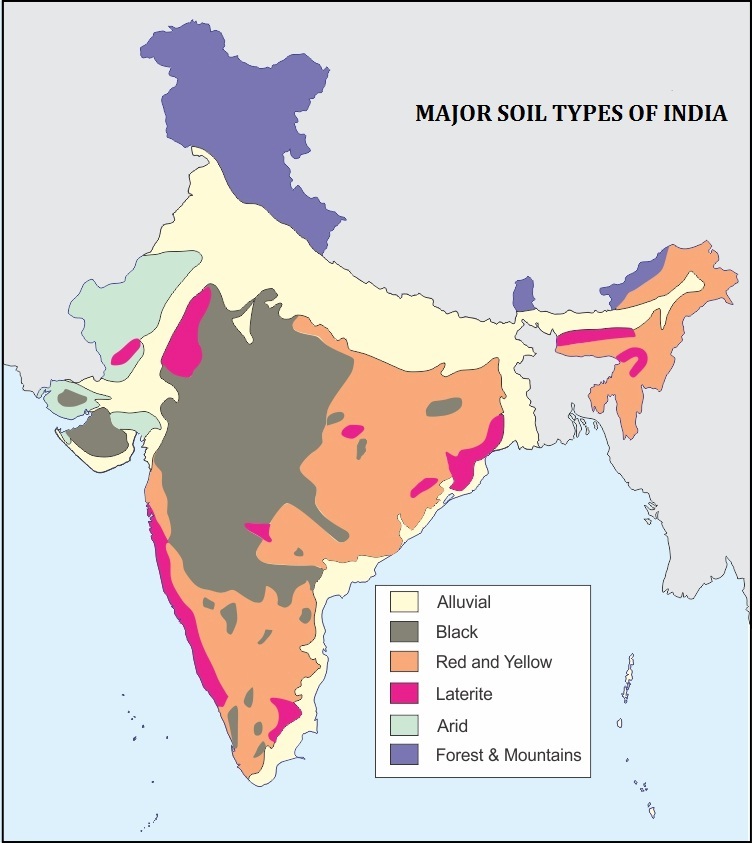Laterite Soil










Laterite Soil
Laterite Soils: The word laterite has been derived from the Latin word later which means brick. It covers about 7.2 per cent of India’s total geographical area. It develops in areas with high temperature and heavy rainfall, resulting in intense leaching due to heavy rain. Some features of laterite soil are given below:
Map of India which shows area/states where laterite soil is found are given below. The places marked with pink depicts the laterite soil.

Which of the following are the features of laterite soil: (a) This soil has low humus content due to the microorganism getting destroyed due to high temperature (b) It can be made cultivable with adequate amounts of manure and chemical fertilizers. (c) It is useful for growing coffee, tea, cashew nut, tapioca cinchona. | |||
| Right Option : D | |||
| View Explanation | |||
Laterite soil is majorly found in _____________________ | |||
| Right Option : C | |||
| View Explanation | |||
Which of the following are correct : (a) Laterite soil is formed due to intense leaching in regions with heavy rainfall. (b) Laterite soil is not naturally fertile as a top soil along with the humus is washed away by heavy rainfall. (c) Laterite soil is used for growing jute millets fodder crop, etc. | |||
| Right Option : D | |||
| View Explanation | |||
Students / Parents Reviews [10]
It was a good experience with Abhyas Academy. I even faced problems in starting but slowly and steadily overcomed. Especially reasoning classes helped me a lot.

Cheshta
10thAbout Abhyas metholodology the teachers are very nice and hardworking toward students.The Centre Head Mrs Anu Sethi is also a brilliant teacher.Abhyas has taught me how to overcome problems and has always taken my doubts and suppoeted me.

Shreya Shrivastava
8thMy experience was very good with Abhyas academy. I am studying here from 6th class and I am satisfied by its results in my life. I improved a lot here ahead of school syllabus.

Ayan Ghosh
8thAbhyas Methodology is very good. It is based on according to student and each child manages accordingly to its properly. Methodology has improved the abilities of students to shine them in future.

Manish Kumar
10thMy experience with Abhyas academy is very good. I did not think that my every subject coming here will be so strong. The main thing is that the online tests had made me learn here more things.

Hiya Gupta
8thAbhyas is a complete education Institute. Here extreme care is taken by teacher with the help of regular exam. Extra classes also conducted by the institute, if the student is weak.

Om Umang
10thI have spent a wonderful time in Abhyas academy. It has made my reasoning more apt, English more stronger and Maths an interesting subject for me. It has given me a habbit of self studying

Yatharthi Sharma
10thOne of the best institutes to develope a child interest in studies.Provides SST and English knowledge also unlike other institutes. Teachers are co operative and friendly online tests andPPT develope practical knowledge also.

Aman Kumar Shrivastava
10thMy experience with Abhyas is very good. I have learnt many things here like vedic maths and reasoning also. Teachers here first take our doubts and then there are assignments to verify our weak points.

Shivam Rana
7thA marvelous experience with Abhyas. I am glad to share that my ward has achieved more than enough at the Ambala ABHYAS centre. Years have passed on and more and more he has gained. May the centre flourish and develop day by day by the grace of God.
